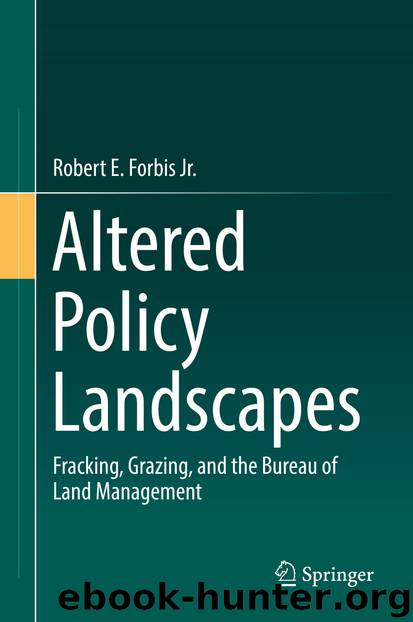Altered Policy Landscapes by Robert E. Forbis Jr

Author:Robert E. Forbis Jr.
Language: eng
Format: epub
ISBN: 9783030047740
Publisher: Springer International Publishing
Shea also notes that the cozy relationship that emerged between ranching and energy developers was a conflict waiting to happen as “the tension between the different constituencies who have an economic dependency on BLM and its policies, ha[d] not been worked out and the split-estate is legal, both by judicial decision and by statutory legislation [and is now] a great example of that split” (P. Shea, personal communication, June 2, 2009). The reality of split-estates is that between the competing economic interests of ranching’s surface use and energy developer’s subsurface use, each interest desires favorable political, legal, and administrative decision-making.
As was discussed in Chap. 2, from the perspective of history, governmental decisions regarding the economic interests of ranching and energy developers corresponded as laws, legal decisions, and regulations were developed. During the period of time in which land management laws were created, the economy of ranching and energy was roughly equivalent, as was their respective use of the public domain, and conflict was avoided. Conflict between ranchers and energy developers did not occur until federal efforts to expand domestic energy development encroached onto private lands where the economic interests of the two interests come into direct conflict with each other. The conflict is perpetuated because of the vested economic and property interests that are shared between property-owning ranchers, energy developers, and the federal government. In many instances, the types of conflicts that emerge between these parties are the result of not having resolved the existing political, legal, and administrative tensions inherent to split-estate energy development.
The contemporary conflict and competition between ranching and energy development are based, therefore, upon unresolved legal, legislative, and policy questions concerning split-estate energy development. These questions remain unresolved because, from the perspective of administrative decision-making, regulation of split-estate energy development is dependent on legal and administrative interpretations of the late nineteenth and early twentieth-century land management legislation. Thus, the modern administrative reality of regulating split-estate energy development is that, “in most split-estates of competing or conflicting interests, nobody at the end of the day is going to be happy. The winner, if you will, is not going to be happy ‘cause they didn’t get everything they asked for, and the loser is just going to say you made the wrong decision” (P. Shea, personal communication, June 2, 2009). Additionally, more unhappiness results from increased numbers of split-estate property owners throughout the Rocky Mountain West. From the period of homesteading to the present time, most large tracts of private ranchlands have changed hands numerous times. As ranchlands were subdivided, mineral rights were often sold or retained independent of surface properties.
As a result of multiple exchanges of property, there is little clarity regarding the decision-making realities of owning private property in the Western United States. The reality is that decision-making power regarding use of property, especially where the surface and mineral estates have been split, is shared among multiple stakeholders. Once the administrative decision has been made to develop energy on the split-estate and the energy lease to
Download
This site does not store any files on its server. We only index and link to content provided by other sites. Please contact the content providers to delete copyright contents if any and email us, we'll remove relevant links or contents immediately.
| Acoustics | Bridges |
| Earthwork Design | Environmental |
| Fire Science | Highway & Traffic |
| Hydrology | Remote Sensing |
| Seismic Design | Structural |
| Structural Dynamics | Surveying & Photogrammetry |
| Transportation |
Whiskies Galore by Ian Buxton(41938)
Introduction to Aircraft Design (Cambridge Aerospace Series) by John P. Fielding(33092)
Small Unmanned Fixed-wing Aircraft Design by Andrew J. Keane Andras Sobester James P. Scanlan & András Sóbester & James P. Scanlan(32764)
Craft Beer for the Homebrewer by Michael Agnew(18196)
Turbulence by E. J. Noyes(7978)
The Complete Stick Figure Physics Tutorials by Allen Sarah(7338)
Kaplan MCAT General Chemistry Review by Kaplan(6900)
The Thirst by Nesbo Jo(6877)
Bad Blood by John Carreyrou(6583)
Modelling of Convective Heat and Mass Transfer in Rotating Flows by Igor V. Shevchuk(6406)
Learning SQL by Alan Beaulieu(6237)
Weapons of Math Destruction by Cathy O'Neil(6215)
Man-made Catastrophes and Risk Information Concealment by Dmitry Chernov & Didier Sornette(5956)
Digital Minimalism by Cal Newport;(5704)
Life 3.0: Being Human in the Age of Artificial Intelligence by Tegmark Max(5516)
iGen by Jean M. Twenge(5385)
Secrets of Antigravity Propulsion: Tesla, UFOs, and Classified Aerospace Technology by Ph.D. Paul A. Laviolette(5333)
Design of Trajectory Optimization Approach for Space Maneuver Vehicle Skip Entry Problems by Runqi Chai & Al Savvaris & Antonios Tsourdos & Senchun Chai(5037)
Pale Blue Dot by Carl Sagan(4953)
